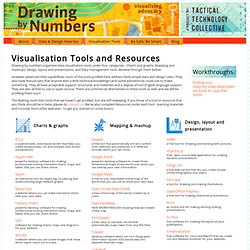

Mitozoos - application. Description Mitozoos is an interactive artificial life model created with the objective that through experimentation and play participants will understand t he relationship between genetic code and life.

The work presents an interface that allows participants to create virtual organisms, called ‘mitozoos’, essentially encoding their DNA, and then witness the evolution of those organisms in a simulated, biological universe. These mitozoos live, reproduce and die, in a system which allows their genetic code to carry on and even mutate, generation after generation. In Mitozoos, genetic information is displayed as a series of color codes, designed taking into account the actual chemical basis of DNA. Play! Up the book of the mitozoos This book is aimed at everyone interested in the Mitozoos project who wants to learn more about its computing, mathematical and biological aspects.
Visualisation Tools and Resources. Drawing by numbers organises data visualisation tools under four categories - Charts and graphs; Mapping and mashups; Design, layout and presentation; and Data management tools.

Browse through them below. However advanced their capabilities, most of the tools profiled here address fairly simple data and design tasks. They also have feature sets that anyone with a little technical knowledge (and some persistence) could use to make something. They all have acceptable support structures and materials and a degree of non-English language support. They are also all free to use or open source. The Waiting room lists tools that we haven't yet profiled, but are still reviewing. Choosel - Choosel: A data visualization framework for GWT. A Periodic Table of Visualization Methods. Combining crowdsourced geodata. 3d Sensing and Visualization. Flapping Toasters. Concept Flapping Toasters is an absurdist reconsideration of the classic screensaver Flying Toasters.

You embody the toaster, flapping your arms to stay aloft, clapping to release toast, and tilting to roll away from danger. Created in collaboration with Michael Edgcumbe. Video Screenshots Clockwise from top left: Basic flapping / Multi-player / Tilting to roll / Clapping to release toast. Background The screensaver is forbidden territory for those seeking to elevate the status of new media art. Michael and I decided to embrace the kitsch, and compound the absurdity of the ever-criticized screen saver with the hype and widespread obsession with the Kinect. Process / Implementation We built the software in openFrameworks.
Detecting flaps was a bit trickier than expected, since there’s an issue of ranging, direction detection, correlating the animation to the arm position, direction reversal detection, etc. We also added support for rolling in both directions. TSPS. Documentation « TSPS. James George. Toolkit for Sensing People in Spaces OpenTSPS is an application and code base for creating interactive software through computer vision.

Designed for use in art, commercial, and educational environments. Intended to integrate with already existing platforms, openTSPS is currently compatible with openFrameworks, processing, Unity3d, Quartz Composer, MaxMSP, and PD. Since it's release in early 2010 I've contributed software development, design recommendations, and 3rd party extensions. OpenTSPS is used for video tracking aspects of Sniff, the Infiniti: Moments of Inspiration project, and the Forth commission.
Made with openFrameworks. » official site » master on github. Pixels to Polygons: Programming 3d Worlds. This course introduces programming 3D geometry to create images interaction between physical and virtual space.
We'll learn how to generate geometry with code, import and control animated models, shader and lighting design, interfacing with hardware and networks, and projection mapping onto physical objects. Emphasis will be placed on the narrative potential of imagining virtual environments and their interaction with physical space. The course will be taught in Unity3d, a powerful, free and industry-standard game production environment. All coding will be done in Javascript. This two-point course will meet in the first seven weeks of the semester. Tuesdays 12:30 - 3:00PM the first seven weeks of the the semester James George james@jamesgeorge.org twitter: @obviousjim skype: obviousjim Important Links Syllabus Projects You may choose to build one large project, adding to it through each of the assignments.
Avoir absolu. My new installation had its first showing at the V&A Sackler Centre from May 30 - June 3, 2011: A lasercut ornamental room divider covered in 620 hand folded paper cones is used as canvas for an interactive & projection-mapped pattern generator.More images on my flickr. More information forthcoming. Just completed teaching two intensive Computational Design workshops at Bezalel Academy of arts and design Jerusalem (11-14 April 2011) and Victoria & Albert Museum London (1 Feb - 29 March 2011). Devised & implemented a new semi-generative, interactive design system to create a collection of 3D printed characters for Universal Everything's La Gaite Lyrique show "Matt Pyke & Friends", open from 21 April - 27 May 2011. Jason Bruges Studio's "Platform 5" at Sunderland Station wins Special projects category at Lighting Design Awards 2011 and commended for Design Week Awards 2011, Digital Installation Category.